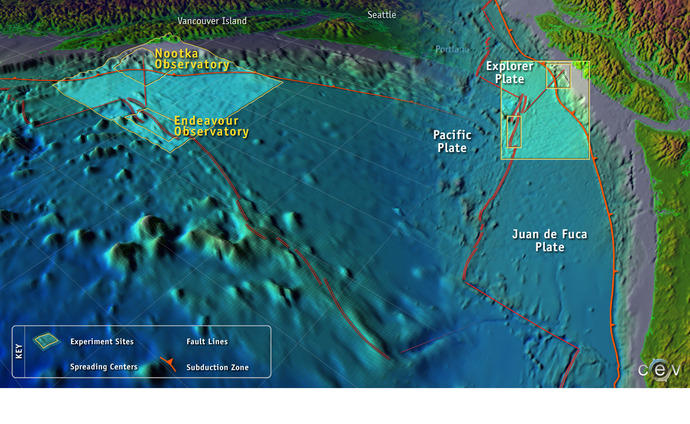Microbes and Rocks: Exploring the Linkages
In 2001, the W.M. Keck Foundation granted $5 million to the NEPTUNE Project at the University of Washington for a five-year experiment to explore newly recognized linkages among processes in the ocean, the seafloor, and microbial communities that live in the rocks beneath. The basic premise is that when seafloor rocks deform, the nutrient-rich fluids set in motion are capable of supporting microbial blooms at the seafloor or within the overlying ocean.
It is not possible to fully test such a hypothesis without establishing a permanent presence on the seafloor that can continuously observe, document, and interact with co-varying processes of deformation, fluid flow, chemistry, and microbial activity. As part of Keck-NEPTUNE program, numerous sensors were developed for cabled observatory work that included in situ microbial incubators, seismic sensors, chemical and fluid samplers, and a micro gas chromatograph.
Prototype Observatories
During the Keck-funded experiment the NEPTUNE project (the precursor to what is now known as the Regional Scale Nodes) used these novel sensors and built a set of prototype observatories located at three major tectonic plate boundaries: the Juan de Fuca Ridge spreading center, the Nootka Transform Fault, and the Cascadia Subduction Zone. these proto-observatory sites were selected along the likely path of the regional ocean observatory cable, so that experience gained during the Keck study would allow early experiments with the cabled observatory system to be optimally designed and effectively implemented.
By 2006 a total of 40 new instruments had been developed and deployed at the undersea observatories. These successes relied on the efforts of multiple interdisciplinary teams from many different oceanographic institutions (including the University of Oregon, Scripps Institution of Oceanography, and the Monterey Bay Aquarium Research Institute) to design the instruments, map the detailed topography of the plate, and coordinate the complex system design and instrument deployment.
Live High-Definition Video from the Seafloor
Other highlights of Keck-funded program included the first-ever real-time broadcast of live high-definition video from the seafloor over the internet. During the VISIONS '05 expedition images were transmitted from a high-definition underwater video camera deployed on a robot vehicle 7,000 feet beneath the ocean's surface. Data traveled from the robot to ship by fiber-optic cable and from ship to the University of Washington via high-bandwidth satellite connection. From the University, the transmission was streamed live over Internet2 to viewers in the U.S., Canada, Australia, and Tokyo.
Life at Extreme Temperatures
An exciting collaborative effort using Keck and funding from the National Science Foundation was the development and deployment of an in situ microbial incubator that examines the extreme conditions under which microbial communities thrive, survive, and expire within the walls of actively venting sulfide chimneys. Analysis of biofilms that grew during this experiment provide hints that life may thrive at temperatures >150°C.
A Seafloor Seismic Network
In addition, a long-term seafloor seismic network was deployed on plate boundaries to characterize seismicity over a 1- to 3-year interval at an active submarine volcano and subduction zone fault. This was one of the first deployments of an extended seafloor seismic network with sensor installation and data quality comparable to a good land network. Results of this work were published in Nature Geoscience.






